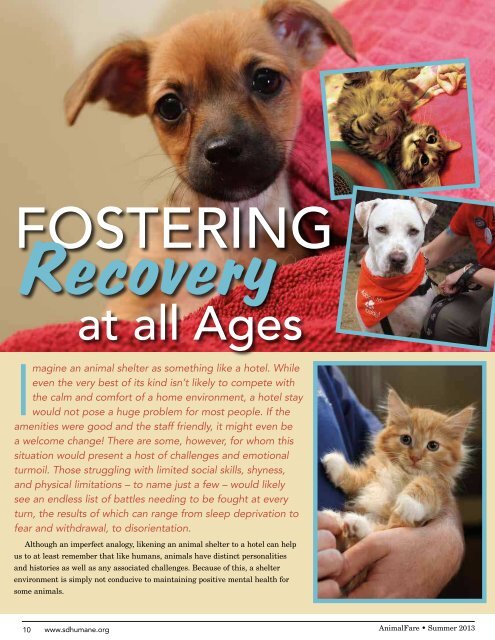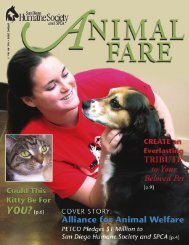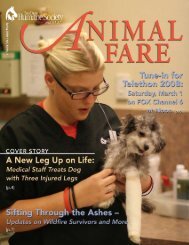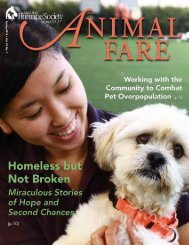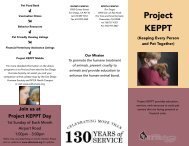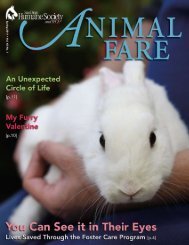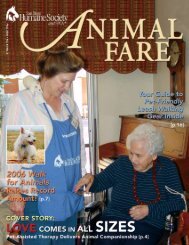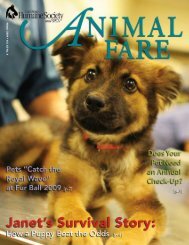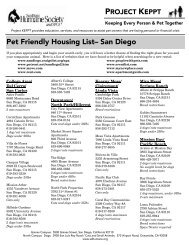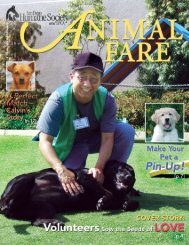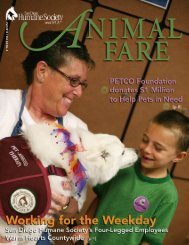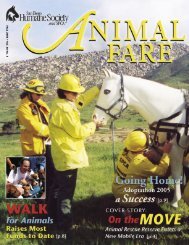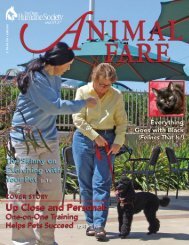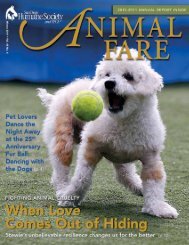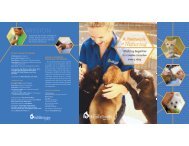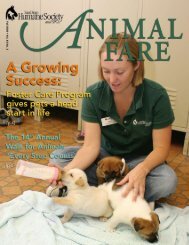Summer 2013 ⢠V ol. 47 No. 2 - San Diego Humane Society and SPCA
Summer 2013 ⢠V ol. 47 No. 2 - San Diego Humane Society and SPCA
Summer 2013 ⢠V ol. 47 No. 2 - San Diego Humane Society and SPCA
Create successful ePaper yourself
Turn your PDF publications into a flip-book with our unique Google optimized e-Paper software.
FOSTERING<br />
Recovery<br />
at all Ages<br />
Imagine an animal shelter as something like a hotel. While<br />
even the very best of its kind isn’t likely to compete with<br />
the calm <strong>and</strong> comfort of a home environment, a hotel stay<br />
would not pose a huge problem for most people. If the<br />
amenities were good <strong>and</strong> the staff friendly, it might even be<br />
a welcome change! There are some, however, for whom this<br />
situation would present a host of challenges <strong>and</strong> emotional<br />
turmoil. Those struggling with limited social skills, shyness,<br />
<strong>and</strong> physical limitations – to name just a few – would likely<br />
see an endless list of battles needing to be fought at every<br />
turn, the results of which can range from sleep deprivation to<br />
fear <strong>and</strong> withdrawal, to disorientation.<br />
Although an imperfect analogy, likening an animal shelter to a hotel can help<br />
us to at least remember that like humans, animals have distinct personalities<br />
<strong>and</strong> histories as well as any associated challenges. Because of this, a shelter<br />
environment is simply not conducive to maintaining positive mental health for<br />
some animals.<br />
cover story<br />
The <strong>San</strong> <strong>Diego</strong> <strong>Humane</strong><br />
<strong>Society</strong> <strong>and</strong> <strong>SPCA</strong>’s Foster<br />
Program is able to provide a<br />
much-needed alternative for<br />
animals who need special,<br />
individualized attention to<br />
thrive. Such was certainly the<br />
case for Toni, a 2-year <strong>ol</strong>d Dutch/<br />
American breed rabbit, who<br />
began to display defensive <strong>and</strong><br />
territorial behavior at our Central Campus whenever anyone<br />
tried to clean her kennel or interact with her. Placing her<br />
in foster care provided an alternate environment for her in<br />
which she did not feel as anxious. With tremendous patience<br />
<strong>and</strong> ongoing promotional efforts from her foster dad, Toni was<br />
given the time she needed to slowly develop trust <strong>and</strong> grow<br />
more comfortable with human interaction. Ultimately, she was<br />
adopted after <strong>47</strong>2 days in our care.<br />
For some animals, being in our foster program not only<br />
helps them on the road to adoption by providing long-term<br />
assistance, it provides the immediate answer to a question<br />
of life or death. An orphaned kitten in the first weeks of<br />
life, for example, is entirely dependent on its mother – for<br />
nourishment, for functionality, for grooming, for socialization<br />
– <strong>and</strong> in her absence the chances of survival decrease<br />
exponentially. Were it not for the surrogate mother r<strong>ol</strong>e that<br />
our foster v<strong>ol</strong>unteers are able to assume during this fragile<br />
<strong>and</strong> formative time in a kitten’s life, the survival of countless<br />
kittens, like <strong>No</strong>el, could be in serious jeopardy.<br />
Kittens like <strong>No</strong>el, who<br />
was found with his five<br />
siblings outside an autosupply<br />
store in Oceanside<br />
last <strong>No</strong>vember. Just days<br />
<strong>ol</strong>d, the helpless kittens<br />
were immediately placed<br />
into foster homes where<br />
they could be given<br />
bottle feedings every<br />
two hours, have heating<br />
pads, grooming, <strong>and</strong> be<br />
<strong>No</strong>el (the kitten)<br />
Toni<br />
monitored around the clock. Once kittens have graduated<br />
from the neonatal stage of their development, they are still<br />
too young <strong>and</strong> fragile to be made available for adoption, <strong>and</strong><br />
therefore remain in the foster program for the next two stages<br />
of their development: the transitional phase (typically from<br />
2-5 weeks of age), <strong>and</strong> the socialization stage (from 5 – 8<br />
weeks, <strong>and</strong> until they are 2 lbs).<br />
We feel incredibly fortunate to have foster v<strong>ol</strong>unteers to<br />
provide this level of care, as most animal shelters do not have<br />
the resources or manpower to affect positive outcomes for many<br />
of the neonates that come into their care. Unfortunately, as a<br />
result, the underage kitten population consistently represents<br />
the highest euthanasia percentage of treatable animals in<br />
shelters across the US. The limited resources at many shelters<br />
can also preclude the viability of offering extended care to<br />
animals at the opposite end of the age spectrum. In addition<br />
to senior animals, those with medical issues also represent<br />
animal populations that can be tremendously jeopardized<br />
without the additional resources <strong>and</strong> care that a foster<br />
program provides. Foster v<strong>ol</strong>unteers also provide a nurturing<br />
environment for animals recovering from medical procedures…<br />
animals like Rita – a 10-year<br />
<strong>ol</strong>d Chihuahua suffering from<br />
severe seizures. Through foster<br />
care she was able to receive<br />
critical monitoring <strong>and</strong> medical<br />
care, ultimately providing her<br />
a second chance to become the<br />
amazing companion she was<br />
meant to be.<br />
Foster. The word itself –<br />
Rita<br />
both a noun <strong>and</strong> a verb – is nearly as multi-faceted as its<br />
r<strong>ol</strong>e within our organization. As we move ever forward in<br />
our efforts to achieve our goal of “getting to zero” – saving<br />
the life of every adoptable animal in <strong>San</strong> <strong>Diego</strong> County<br />
Coalition Shelters – it is resources like foster care that<br />
provide invaluable s<strong>ol</strong>utions for animals who require care<br />
outside of the shelter environment, while simultaneously<br />
allowing us to fill those vacant habitat spaces within our<br />
walls with additional homeless animals. We remain more<br />
committed than ever to increasing our adoption numbers<br />
<strong>and</strong> finding loving homes for all of the amazing animals we<br />
serve day in <strong>and</strong> day out. Among the numerous exciting goals<br />
<strong>and</strong> directives that we have set organization-wide, we are<br />
greatly increasing the number of animals who will be able to<br />
benefit from our Foster Program, thus helping to ensure that<br />
<strong>San</strong> <strong>Diego</strong> remains one of the very best cities to own <strong>and</strong> –<br />
perhaps most importantly – to be a pet.<br />
In our ongoing c<strong>ol</strong>laborative efforts to find ways to<br />
G20 (“Get to Zero”), the Foster Program has set an<br />
ambitious goal for the upcoming year to provide<br />
foster care for 1,500 animals. To become a foster<br />
v<strong>ol</strong>unteer, please email V<strong>ol</strong>info@sdhumane.org”<br />
10 www.sdhumane.org<br />
AnimalFare • <strong>Summer</strong> <strong>2013</strong><br />
AnimalFare • <strong>Summer</strong> <strong>2013</strong><br />
www.sdhumane.org<br />
11


